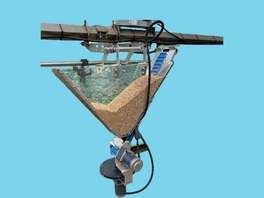- Premium solutions & products
- Global presence with local support
- Quotation within 24 hours
+61 447 734 654 
- Request a quote
- Become a customer
+61 447 734 654 
The most common pests effecting cannabis crops are mites and aphids, however Thrip and whitefly can also be extremely problematic. By employing a highly proactive strategy with our Beneficial’s we can prevent the pest pressure from becoming a problem. Utilising products with in our range we build the population of beneficial bio’s in the crop prior to the pests being present or having the opportunity to establish themselves, in this way we maximise our chances of managing the pest pressure successfully.

How to optimise the function of natural predators in the crop.
Good material
The initial Key to any good IPM strategy is high quality material. By using products from an acknowledged producer or distributor, you are assured of having quality products that will be delivered in time. Can Hub supplies the natural predators from our partners at Agrobío. They are one of the premium producers of biological agents worldwide. Can Hubs world wide supply chain combined with Agrobio premium products ensures that the predators arrive on site in pristine condition and when the grower needs them.
Quality check and practical research
The second key element is constant and rigorous quality checks combined with ongoing practical research. Natural predators are living organisms which makes them very vulnerable products. Therefore, checks on quality after transport and checks on effectivity in practice are extremely important. Our quality team is involved with this every day. As such, we are able to guarantee the quality of the delivered product and advise growers concerning their application strategy. This is highly important for successful suppression.
Optimal distribution
The third Key is an optimal distribution of the natural predators in the crop. The more uniformly the bugs are released in the crop, the better the results will be. Additionally, concerning the release of the product it is very important that this is done the right way, thus retaining the maximum number of natural predators and ensuring they arrive in the correct part of the crop Ready to do their job in optimum condition. This can be done manually, but the best results are achieved with:
The Bio divider in the chrysanthemum cultivation
The Monorail in combination with the Bio divider in pot plant cultivation (due to the presence of an electrically driven wheel set, this is mainly convenient for horticulturists who do not have a spray boom).
The Bio slider in cucumber cultivation
Agrobio handblower This hand blower is very suitable for blowing especially predatory mites (montdorensis/swirskii/Cucumeris on to beds) but can also be used for other insects.



Products
Predatory mites
Agrobio produces all the different mites species to counter the pests we face in Cannabis like Thrips, broad mite, russet mite ans spider mites but also whitefly species.
N. Cucumeris. A. swirskii, T. montdorensis & S. scimitus against the different Thrips species.
P. persimillis, A. andersoni & N. californicus against spider mites.
We use feeding strategys to increase the mite popualtion, this means we will start feeding predatory mites from the start with living prey mites to build up a population very quickly.
The predatory mites will always prefer the pest but when there is none they have still fresh protein for them to eat.
Parasitic wasps & other aphid controls
We use different mixes of parasitic wasps to counter aphids. All the regular species are included like: A.colemani, A. ervi, etc. we combine these with Aphidoletes aphidimyza (galmidge) and Chrysoperla larvae and sometimes even adalia larvae (ladybirds).
We use a specific system to introduce Aphidoletes aphidimyza, we supply them in a cardboard tube which you will place in the greenhouse, this way the pupae are well sheltered and conditions in the tube are ideal for them to hatch.
Other products
Nemathodes against fungus gnats & shore fly’s
Oris leavigatus against thrip species
Dalotio coriaria against thrip species
Contact Can Hub to discuss the options available to you to draw up and maintain a top quality IPM strategy tailored to your crops, issues and requirements.
Thrip (Frankliniella occidentalis, Scirtothrips dorsalis)
To control Thrip we use a strategy that includes different species of predatory mites, predatory bugs and more, down below the main predators we use in a cannabis crop.
• Neoseiulus cucumeris (formerly known as Amblyseius cucumeris) is used to control several species of thrips, especially Frankliniella occidentalis. Neoseiulus cucumeris is a mite from the phytoseiid family. They also eat red spider mites, broad mites and other similar insects. They can survive without thrips if they find plants with pollen.
• Transeius montdorensis (formerly known as Amblyseius montdorensis) is a predatory mite from family of Phytoseids. It feeds on thrip, white fly, mites, small arthropods and pollen.
• Orius laevigatus is a predatory bug from family Anthocoridae. This bug eats thrips and pollen. Adults can fly and find the prey easily. Once the prey is found, this species bites it and eats its content. O. laevigatus can eat about 20 thrips per day.
Aphid (Aphys gossypii, Myzus persicae/nicotianae, Macrosiphum euphorbiae, Aulacorthum solani)
To control the different aphid species, we use a wide range of predators like parasitic wasps, ladybird larvae and more. Down below more info on the main predators we use against aphids.
• Adalia bipunctata is a coleopteran, from the coccinelid family. It is known as “two-pointed ladybird”, and is used to control several aphid species.
• Aphidoletes aphidimyza is a mosquito from family Cecidomyiidae, and its larvae control effectively the aphids from family Aphidae. The A. aphidimyza lays its eggs on plants that have a high population of aphids, in the underside of the leaves. When the larva of A. aphidimyza finds the prey, it injects a toxin into it and eats the aphid 10 minutes later.
• ORNAcontrol, this product is a mix of the parasitoids Aphidius colemani, Aphidius matricariae, Aphidius ervi, Aphelinus abdominalis, Ephedrus cerasicola and Praon volucre. ORNAcontrol has been designed to control the main species of aphids present in horticultural crops. They can parasitize aphids of any stage, including the winged ones. In addition to parasitism the individuals release a pheromone that incites the aphids to let themselves fall into the ground, dying some of them in the process.
• Chrysoperla carnea is an aphid predator, and can help to control other pests like white fly or thrips. Only the larvae of the C. carnea are active predators. In case of lack of aphids, C. carnea can survive eating mites, thrips and small lepidoptera.
Red-spider (Tetranychus urticae)
To Control red spider we use predatory mites and a midge. Down below more specific information about the predators.
• Amblyseius andersoni is a polyphagous phytoseid. It feeds on mites from families Tetranychidae, especially Panonychus ulmi, Eriophyidae and also pollen. A. andersoni has a good performance in both indoor and outdoor crops and is usually used to control spider mite pests.
• The adults of Feltiella acarisuga are unable to find single red spider mites. However, they can find the hot spot of red spider mites, and lay their eggs close to these hot spots. The larva which comes from the egg eats the eggs, nymphs or adults of red spider mites. The F. acarisuga larvae can control effectively large populations of red spider mites. The adults are not predators, and they only need water and sugar to survive.
• Phytoseiulus persimilis is a predatory mite of red spider mite. Once the spider hot spot is found, the female lays its eggs on it. From each egg will emerge a larva that eats 5 adults or 20 eggs per day depending on the stage, until it becomes an adult. P. persimilis eats all the stages of the red spider mite, although it prefers young spiders.
Broad & Russetmite
To control these pests, we use two different species of predatory mite, Amblyseius andersoni against Hemp russet mite and Neoseiulus cucumeris against Broad mites, down below more information on both products.
• Amblyseius andersoni is a polyphagous phytoseid. It feeds on mites from families Tetranychidae, especially Panonychus ulmi, Eriophyidae and also pollen. A. andersoni has a good performance in both indoor and outdoor crops and is usually used to control spider mite pests.
• Neoseiulus cucumeris (formerly known as Amblyseius cucumeris) is used to control several species of thrips, especially Frankliniella occidentalis. Neoseuilus cucumeris is a mite from the phytoseiid family. They also eat red spider mites, broad mites and other similar insects. They can survive without thrips if they find plants with pollen.
Information
If you have any questions or if you would like to get more information on the products like: pack sizes, lead times, how to apply, etc. please let us know.